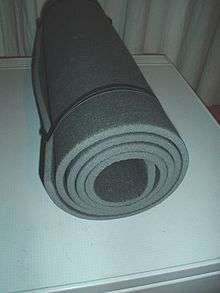Sleeping pad

In camping, a ground pad, sleeping pad, sleeping mat, roll mat, or iso mat is a simple device often used in conjunction with a sleeping bag. Its purpose is to provide padding and thermal insulation. All types currently available use air as their primary form of insulation.
Types
Manually inflated
Closely related to the air mattress, a pad of this type requires an external pressure source to inflate, typically in the form of a pump or by blowing orally.[1] Convection of the air inside the mattress reduces the amount of insulation it provides. More complicated mattresses reduce convection by partitioning the internal cavities,[2] or by filling the cavities with material to trap the air such as down feathers[3] or synthetic insulation. Manually inflated pads have the advantage of offering good thickness and a great deal of comfort while being lightweight and able to pack to a small size.

Self inflating
An extension on the conventional manually inflated mattress, this type is capable of self-inflation due to the open-cell foam that fills the internal cavity. For many years this design was protected by various patents held by Cascade Designs[4] and they were an unusual and premium item. But since these patents expired many other manufacturers are now producing this type of mattress and they are now commonplace. These mattresses are lightweight and pack to a small size, which make them popular amongst hikers and campers. A self-inflating mat typically measures 183x51x3.8 cm, weighs about 700 g, and packs to about 28x16 cm.
Foam
Closed-cell foam is used to produce mats that can be used without requiring any inflation. Closed-cell foam pads are lighter and more durable than their air-filled counterparts, as they are constructed of fewer materials and not susceptible to damage from accidental puncture. Many may also be trimmed to size should the user choose to do so. However, they are generally not as comfortable as air-filled mats because they are thinner, and may also take up more space in a pack, depending on the materials used. Variations include textured or shaped foam to increase the unrolled volume and/or change the stiffness of the mattress. This can also be used to trap the air within ridges or an egg-carton type of texture.
Open-cell foam, although comfortable, is rarely used in the outdoors due to its ability to absorb water (like a sponge) and its air cells are crushed in use reducing its insulation capacity.
Color
Color and reflectivity have no impact on a pad's insulating ability. Just like with clothing and sleeping bags, the interior color (flat black, shiny silver, white, or orange) makes no difference in warmth.[5]
Insulation / Ratings
A sleeping pads's warmth is characterized by R-value. But unlike sleeping bags' EN 13537 test standard and widely accepted recommendations,[6] sleeping pad R-values lacks a simple mapping and label for 'how much warmth' a consumer should expect. Combining various standards[7] and various authors' research,[8][9][10][11][12] an approximate R-value to temperature chart follows:
| Air/Ground Temperature | R-value for Standard | |
|---|---|---|
| male | female | |
| 40 °F | 5 | 6 |
| 20 °F | 7 | 8 |
| 0 °F | 9 | 10 |
| −20 °F | 11 | 13 |
Same as EN 13537, a "standard man" is assumed to be 25 years old, with a height of 1.73 m and a weight of 73 kg; a "standard woman" is assumed to be 25 years old, with a height of 1.60 m and a weight of 60 kg. The sleeping bag and pad system (above, below, and sides) should provide the same insulation value all around a person, but cost, size, weight, comfort, and lack-of-knowledge often lead persons to reduce the R-value to below their personal 'recommended R-value'. Since the pad and bag work together, a 'warmer' bag can compensate the a 'thin' pad and a 'thick pad' for a 'cold' bag. Highly heat-conductive surfaces (e.g. concrete, granite)[13][14] require more insulation for the same temperature than insulating ground surfaces (e.g.snow, dry moss, loose soil, wood, etc.). More heat is lost downward when sleeping on one's stomach vs sleeping one's side (due to reduced contact area and cooler body parts in contact). Most persons can 'feel the cold ground' at approximately half the 'recommended R-values'.
Sleeping pads R-values range from 1 to more than 10.[8] A few category examples follow:
| Make/ Model | R-value | Approximate cost |
|---|---|---|
| Common air mattress | 0.7 | 10 $USD |
| Common 3/8” closed-cell foam pad | 1.4 | 10 $USD |
| Advanced foam pad | 3.5 | 40 $USD |
| 1" self-inflating mat | 3.4 | 70 $USD |
| Advanced air mattress | 6 | 200 $USD |
| Down-filled air mattress | 9 | 200 $USD |
| 2" folding DIY EPS foam[15] | 10 | 15 $USD |
See also
| Look up camping mat in Wiktionary, the free dictionary. |
References
- ↑ "How to Choose a Sleeping Pad". Eastern Mountain Sports. Retrieved 13 February 2015.
- ↑ "Therm-a-Rest NeoAir XTherm Sleeping Pad Review - Section Hikers Backpacking Blog". sectionhiker.com.
- ↑ "DownMat 9 LW".
- ↑ Lea et al. 1979. Method of making a self-inflating air mattress. 4,149,919.
- ↑ "big agnes mummy style mattresses - Backpacking Light".
- ↑ "Backpacking Light Position Statement on Sleeping Bag Temperature Ratings - Backpacking Light". 20 December 2004.
- ↑ "Determining ideal R-value for pads - Backpacking Light".
- 1 2 "Sleeping Pad R Values - Section Hikers Backpacking Blog". sectionhiker.com.
- ↑ "Some thoughts on R-value".
- ↑ "R-value: The meaning behind the number - Therm-a-Rest Blog". 7 January 2015.
- ↑ "Sleeping System". www.verber.com.
- ↑ "The Best Sleeping Pads for Backpacking and Car Camping".
- ↑ "Thermal Conductivity of common Materials and Gases". www.engineeringtoolbox.com.
- ↑ "Mattress Picks". Saturday, 10 June 2017
- ↑ sweerek (12 September 2015). "Diy sleeping pad, eps accordian, 27mar15".